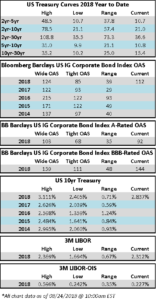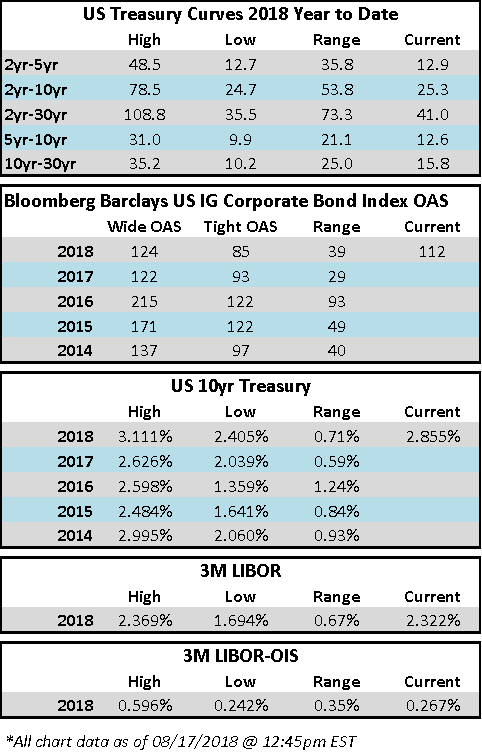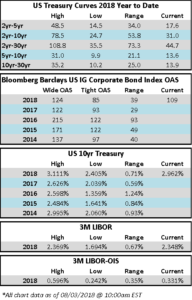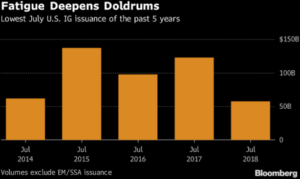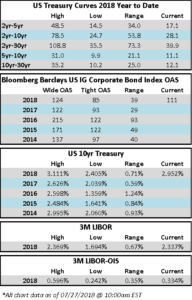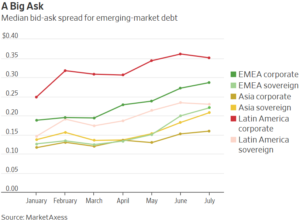Fund Flows & Issuance: According to a Wells Fargo report, flows week to date were $0.4 billion and year to date flows stand at -$33.5 billion. New issuance for the week was $0.0 billion and year to date HY is at $131.2 billion, which is -24% over the same period last year.
(Bloomberg) High Yield Market Highlights
- U.S. high-yield bond activity was muted this week, with no pricings or launches to speak of in the market. Issuance so far this year is the lowest YTD total since 2010
- YTD total return is 2.05%
- Yields gained across ratings
(Reuters) Aluminum products maker Arconic in talks to sell itself
- Aluminum products maker Arconic Inc is discussing acquisition offers for the entire company, even though it announced a sale process last month only for its building and construction systems unit, people familiar with the matter said.
- The move comes after Arconic, which was spun out of Alcoa Corp in 2016, said in February it would carry out a “strategy and portfolio review,” to be completed by the end of 2018, but has provided little detail about what this entails.
- Arconic is speaking with private equity firms that have shown interest in acquiring the company, including a consortium of Blackstone Group LP and Carlyle Group LP, another consortium of KKR & Co and Onex Corp, as well as Apollo Global Management LLC, the sources said.
(Chicago Business Journal) After scotched $3.9B merger, Sinclair-Tribune in dueling lawsuits
- After the proposed $3.9 billion acquisition of Tribune Media Company by Sinclair Broadcast Group Inc. went south earlier this month, the two media giants have filed dueling lawsuits.
- On Aug. 9, Chicago-based Tribune Media sued Maryland-based Sinclair for $1 billion for breach of contract and misconduct “to hold Sinclair accountable” after the $3.9 billion deal fell apart.
- It fell apart mainly because in July FCC Chairman Ajit Pai expressed “serious concerns” about the Sinclair-Tribune Media deal and ordered a hearing on the deal in front of an administrative law judge that essentially killed the deal.
- Sinclair fired back at Tribune Media, filing a countersuit in the Delaware Court of Chancery, claiming that the Chicago media company “is seeking to capitalize on an unfavorable and unexpected reaction from the Federal Communications Commission to capture a windfall for Tribune.”
- In a statement, Chris Ripley, president and CEO, says Sinclair “fully complied with our obligations under the merger agreement and worked tirelessly to close the transaction.”
(Modern Healthcare) California Assembly passes bill to cap dialysis reimbursement
- In a major blow to dialysis giants DaVita Healthcare Partners and Fresenius Medical Care, the California Assembly late Wednesday passed a bill to crack down on third-party premium assistance for dialysis and cap providers’ reimbursement to Medicare rates if they don’t comply with the mandate.
- The legislation now has a good chance of getting signed into law by Democratic Gov. Jerry Brown. It would serve as a landmark victory for insurers and unions in the long-brewing battle with the dialysis industry. The bill takes aim at the American Kidney Fund, a not-for-profit that subsidizes individual market premiums for dialysis patients who are covered by Medicare and Medicaid. DaVita and Fresenius are major contributors to the organization, and insurers accuse them of using Obamacare’s guaranteed issue provision to game the system and steer patients into plans that will bring in more profits.
- The bill isn’t the only battle DaVita and Fresenius are fighting in California. There is also Proposition 8, a ballot measure pushed by one of the country’s largest hospital unions, Service Employees International Union–United Healthcare Workers West (SEIU). The measure would slash dialysis reimbursement to 115% of cost, and a healthcare coalition backed by DaVita and Fresenius said the measure could bleed losses for the dialysis corporations, hospitals and even state and federal coffers.
- The union tried to secure similar ballot initiatives in Arizona and Ohio but failed. In California, dialysis and union groups have spent more than $40 million in the advertising fight over the initiative.
